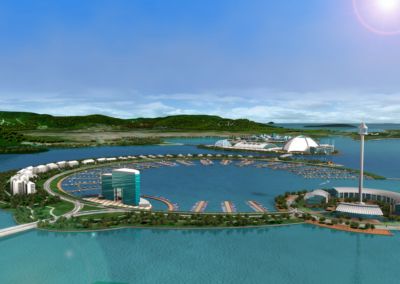Ao Phuket project given top-level green light

PHUKET: The government of Prime Minister Samak Sundaravej has given the green light to the Ao Phuket development plan, a 100-billion-baht megaproject on 3,000 rai of reclaimed land that would include a convention center, marina and other facilities.
The latest movement in the Ao Phuket plan, first conceived over two decades ago, follows from PM Samak’s assigning responsibility for the project to the the Designated Areas for Sustainable Tourism Administration (DASTA), a public organization under the direction of the Ministry of Tourism and Sports established in 2005 under the first Thaksin government.
Phuket Governor Niran Kalayanamit met with DASTA’s Ao Phuket working committee at the Phuket Merlin Hotel on May 2.
The Ao Phuket committee, accompanied by DASTA chairman Gen Soonthorn Khumkomkul, earlier that morning traveled to the waterfront to view the intended project site, which stretches across Phuket Bay all the way from Saphan Hin to Rassada Harbor.
Also attending the meeting were representatives from Phuket City Municipality, the Tourism Authority of Thailand South Region 4 Office in Phuket, the Phuket Tourist Association, Muang District Office, Rassada and Wichit municipalities and other agencies.
PM Samak in March 2008 authorized the DASTA to take responsibility for areas it deems as appropriate for “sustainable” tourism development.
Rajathin Syamananda, who heads DASTA’s Ao Phuket project committee, is well acquainted with the project as a former director-general of the Interior Ministry’s Town and Country Planning Department.
Allowing DASTA to develop the project meant it could be fast-tracked, he said.
“As we have full authority from the government, we can pass the project proposal on for Cabinet much more easily,” said K. Rajathin.
Before the Ao Phuket project was put on hold following the coup, responsibility for it fell to the Town and Country Planning Department, who put a 63.5 billion baht price tag on the designs it drew up.
That plan in many ways resembled a spectacular 130-billion-baht plan plan put forward for the project in 2005 by Japanese construction specialist Umezawa Tadao – except that the Japanese design called for a “floating city”, not one on reclaimed land.
“The most important aspect of this development will be environmental and natural resource conservation, and ensuring that it improves the lives of local people,” he said.
Extensive land reclamation in the shallow Phuket Bay, into which most of the wastewater from Muang and Kathu districts flows, would not impede drainage there, he said.
Other infrastructure aspects including traffic, wastewater treatment and power supply needs have been carefully considered and quantified, he said.
K. Rajathin is confident that the Town and Country Planning Department’s plan, if allowed to go forward under DASTA’s management, would attract a good deal of foreign investment and benefit both Phuket and Thailand.
DASTA’s role will be to co-ordinate the efforts of the many government agencies involved and present the project to potential investors. After the previous Ao Phuket committee first posted information about the plan back in 2003, there was a great deal of interest from investors in Canada, Japan, China and Thailand, he said.
“Now that DASTA is fully authorized to lead the project, it will not fail again. We will work as quickly as possible to iron out all the legal and investment issues so that it can move forward,” he said.
The DASTA committee will re-evaluate the plan put forward by the previous committee in light of changing conditions, he said.
Not expected to change would be the project’s two main attractions: a marina and facilities for Meetings, Incentives, Conventions and Exhibitions, or MICE.
The MICE facilities would comprise: “Phuket Arena”, a 40,000-square-meter convention center with the capacity to host events for up to 15,000 people; two exhibition areas of 60,000 and 30,000 sqm each; a 40,000-sqm business center with space for 100 businesses to rent; a 1,000-room hotel complex; and a 60,000 sqm shopping center featuring shopping malls, souvenir shops, restaurants, cinemas and other facilities.
The circular, 690-rai marina development to the south would include berthing facilities for superyachts, hundreds of slips for smaller vessels, a retail and commercial center, repair and maintenance facilities, and apartment or condominium blocks.
On the economic front, K. Rajathin said the original cost estimate of 63.5 billion baht when the plans were drawn up might no longer be practical.
The total price tag would probably hit 100 billion baht, he said.
To begin, an initial budget of 4.9 billion baht would be needed from the government. The project could generate 19.5 billion baht in revenue annually once it is completed, he said.
Governor Niran said he was in total agreement with the plan. His idea to establish an international convention center on Treasury Department land in Mai Khao was launched on the assumption that the Ao Phuket project would never move forward, he told the committee.
Latest Thailand News
Follow The Thaiger on Google News:
























